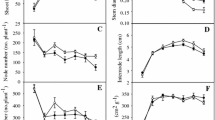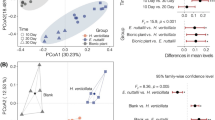Abstract
Some environmental factors, such as brownification and eutrophication, may influence the successful invasions of non-native submerged macrophytes. However, few studies have focused on how interactions between these factors influence the performance of exotic submerged plants. Here, we conducted an experiment in 60 indoor containers (170 l) over 68 days using the native species Hydrilla verticillata (L. f.) Royle and the non-native species Elodea nuttallii (Planch.) St. John to test the effects of brownification, eutrophication and their interactions on the growth and competition of native and non-native aquatic plants. Our results showed that the biomass of both H. verticillata and E. nuttallii increased in the brown water treatment and that eutrophication and water brownification did not lead to a shift from a native species-dominated system to a non-native-dominated system. However, brown water treatment decreased the relative competitive ability of E. nuttallii, and this decrease was exacerbated when brown water and nutrient treatments were combined. Our results indicated that some environmental factors, such as water brownification, eutrophication and their interactions, may not benefit the competition of some non-native submerged macrophytes. Further studies with more species are needed to corroborate these conclusions.





Similar content being viewed by others
References
Alpert, P., E. Bone & C. Holzapfel, 2000. Invasiveness, invasibility and the role of environmental stress in the spread of non-native plants. Perspectives in Plant Ecology, Evolution and Systematics 3: 52–66.
Arthaud, F., M. Mousset, D. Vallod, J. Robin, A. Wezel & G. Bornette, 2012. Effect of light stress from phytoplankton on the relationship between aquatic vegetation and the propagule bank in shallow lakes. Freshwater Biology 57: 666–675.
Bertness, M. D. & R. Callaway, 1994. Positive interactions in communities. Trends in Ecology & Evolution 9: 191–193.
Bianchini, I., M. B. Cunha-Santino, J. A. M. Milan, C. J. Rodrigues & J. H. P. Dias, 2010. Growth of Hydrilla verticillata (L.f.) Royle under controlled conditions. Hydrobiologia 644: 301–312.
Blaser, W. J., J. Sitters, S. P. Hart, P. J. Edwards & H. Olde Venterink, 2013. Facilitative or competitive effects of woody plants on understorey vegetation depend on N-fixation, canopy shape and rainfall. Journal of Ecology 101: 1598–1603.
Bornette, G. & S. Puijalon, 2011. Response of aquatic plants to abiotic factors: a review. Aquatic Sciences 73: 1–14.
Cook, C. D. K. & K. Urmi-König, 1985. A revision of the genus Elodea (Hydrocharitaceae). Aquatic Botany 21: 111–156.
Crain, C. M., 2008. Interactions between marsh plant species vary in direction and strength depending on environmental and consumer context. Journal of Ecology 96(1): 166–173.
Davis, M. A., J. P. Grime & K. Thompson, 2000. Fluctuating resources in plant communities: a general theory of invasibility. Journal of Ecology 88: 528–534.
Dawson, W., R. P. Rohr, M. van Kleunen & M. Fischer, 2012. Alien plant species with a wider global distribution are better able to capitalize on increased resource availability. New Phytologist 194: 859–867.
Elser, J. J., M. E. S. Bracken, E. E. Cleland, D. S. Gruner, W. S. Harpole, H. Hillebrand, J. T. Ngai, E. W. Seabloom, J. B. Shurin & J. E. Smith, 2007. Global analysis of nitrogen and phosphorus limitation of primary producers in freshwater, marine and terrestrial ecosystems. Ecology Letters 10: 1135–1142.
Feuchtmayr, H., R. Moran, K. Hatton, L. Connor, T. Heyes, B. Moss, I. Harvey & D. Atkinson, 2009. Global warming and eutrophication: effects on water chemistry and autotrophic communities in experimental hypertrophic shallow lake mesocosms. Journal of Applied Ecology 46: 713–723.
Flores-Moreno, H., P. B. Reich, E. M. Lind, L. L. Sullivan, E. W. Seabloom, L. Yahdjian & J. D. Bakker, 2016. Climate modifies response of non-native and native species richness to nutrient enrichment. Philosophical Transactions of the Royal Society B 371(1694): 20150273.
Galil, B. S., S. Nehring & V. Panov, 2007. Waterways as invasion highways – impact of climate change and globalization. In Nentwig, W. (ed.), Biological invasions. Springer, Heidelberg: 59–74.
Graneli, W., 2012. Brownification of lakes. In Bengtsson, L., R. W. Herschy & R. W. Fairbridge (eds), Encyclopedia of Lakes and Reservoirs. Springer, Dordrecht: 117–119.
Hansson, L. A., A. Nicolle, W. Graneli, P. Hallgren, E. Kritzberg, A. Persson, J. Bjork, P. A. Nilsson & C. Bronmark, 2013. Food-chain length alters community responses to global change in aquatic systems. Nature Climate Change 3: 228–233.
Havens, K. E., B. Sharfstein, M. A. Brady, T. L. East, M. C. Harwell, R. P. Maki & A. J. Rodusky, 2004. Recovery of submerged plants from high water stress in a large subtropical lake in Florida, USA. Aquatic Botany 78: 67–82.
He, Q. & M. D. Bertness, 2014. Extreme stresses, niches, and positive species interactions along stress gradients. Ecology 95: 1437–1443.
Hidding, B., R. J. Brederveld & B. A. Nolet, 2010. How a bottom-dweller beats the canopy: inhibition of an aquatic weed (Potamogeton pectinatus) by macroalgae (Chara spp.). Freshwater Biology 55: 1758–1768.
Karlsson, J., P. Bystrom, J. Ask, P. Ask, L. Persson & M. Jansson, 2009. Light limitation of nutrient-poor lake ecosystems. Nature 460: 506–509.
Mony, C., T. J. Koschnick, W. T. Haller & S. Muller, 2007. Competition between two invasive Hydrocharitaceae (Hydrilla verticillata (L.f.) (Royle) and Egeria densa (Planch)) as influenced by sediment fertility and season. Aquatic Botany 86: 236–242.
Mormul, R. P., J. Ahlgren, M. K. Ekvall, L. A. Hansson & C. Brönmark, 2012. Water brownification may increase the invasibility of a submerged non-native macrophyte. Biological Invasions 14: 2091–2099.
Palacio-López, K. & E. Gianoli, 2011. Invasive plants do not display greater phenotypic plasticity than their native or non-invasive counterparts: a meta-analysis. Oikos 120: 1393–1401.
Phillips, G. L., D. Eminson & B. Moss, 1978. A mechanism to account for macrophyte decline in progressively eutrophicated freshwaters. Aquatic Botany 4: 103–126.
Rautio, M. & B. Tartarotti, 2010. UV radiation and freshwater zooplankton: damage, protection and recovery. Freshwater Reviews: A Journal of the Freshwater Biological Association 3: 105–131.
Rodriguez, L. F., 2006. Can invasive species facilitate native species? Evidence of how, when, and why these impacts occur. Biological Invasions 8(4): 927–939.
Salonen, K. & A. Vähätalo, 1994. Photochemical mineralisation of dissolved organic matter in lake Skjervatjern. Environment International 20: 307–312.
Shen, X. Y., S. L. Peng, B. M. Chen, J. X. Pang, L. Y. Chen, H. M. Xu & Y. P. Hou, 2011. Do higher resource capture ability and utilization efficiency facilitate the successful invasion of native plants? Biological Invasions 13: 869–881.
Silveira, M. J., S. M. Thomaz, R. P. Mormul & F. P. Camacho, 2009. Effects of desiccation and sediment type on early regeneration of plant fragments of three species of aquatic macrophytes. International Review of Hydrobiology 94: 169–178.
Smith, V. H. & D. W. Schindler, 2009. Eutrophication science: where do we go from here? Trends in Ecology & Evolution 24: 201–207.
Solomon, C. T., S. E. Jones, B. C. Weidel, I. Buffam, M. L. Fork, J. Karlsson, S. Larsen, J. T. Lennon, J. S. Read, S. Sadro & J. E. Saros, 2015. Ecosystem consequences of changing inputs of terrestrial dissolved organic matter to lakes: current knowledge and future challenges. Ecosystems 18: 376–389.
Sousa, W. T. Z., S. M. Thomaz, K. J. Murphy, M. J. Silveira & R. P. Mormul, 2009. Environmental predictors of the occurrence of exotic Hydrilla verticillata (L.f.) Royle and native Egeria najas Planch in a sub-tropical river floodplain: the Upper River Paraná, Brazil. Hydrobiologia 632: 65–78.
Sparks, D. L. & J. M. Bartels, 1996. Methods of soil analysis: chemical methods. Soil Science Society of America, Madison.
Sterner, R. W. & J. J. Elser, 2002. Ecological stoichiometry: the biology of elements from molecules to the biosphere. Princeton University Press, Princeton.
Stiers, I., J. Njambuya & L. Triest, 2011. Competitive abilities of invasive Lagarosiphon major and native Ceratophyllum demersum in monocultures and mixed cultures in relation to experimental sediment dredging. Aquatic Botany 95: 161–166.
Tavechio, W. L. G. & S. M. Thomaz, 2003. Effects of light on the growth and photosynthesis of Egeria najas planchon. Brazilian Archives of Biology and Technology 46: 203–209.
Vähätalo, A. & K. Salonen, 1997. Photochemical degradation of chromophoric dissolved organic matter and its contribution to bacterial respiration in a humic lake. Nord Humus Newslett 4: 14.
Valéry, L., H. Fritz, J. C. Lefeuvre & D. Simberloff, 2008. In search of a real definition of the biological invasion phenomenon itself. Biological Invasions 10: 1345–1351.
Wang, Y. L., Y. Y. Gao, D. Yu & C. H. Liu, 2015. Physiological response of three submerged macrophytes to the high temperature and light intensity of summer. Journal of Hydroecology 5: 95–101.
Weigelt, A. & P. Jolliffe, 2003. Indices of plant competition. Journal of Ecology 91: 707–720.
Williamson, C. E., B. R. Hargreaves, P. S. Orr & P. A. Lovera, 1999. Does UV play a role in changes in predation and zooplankton community structure in acidified lakes? Limnology and Oceanography 44: 774–783.
Xie, D., D. Yu, W. H. You & L. G. Wang, 2013. Algae mediate submerged macrophyte response to nutrient and dissolved inorganic carbon loading: a mesocosm study on different species. Chemosphere 93: 1301–1308.
Xu, J. W., W. Li, G. Liu, L. Zhang & W. Liu, 2007. Inter-specific competition between two submerged macrophytes, Elodea nuttallii and Hydrilla verticillata. Journal of Plant Ecology (Chinese Version) 31: 83–92.
Yang, Q. & W. Li, 1989. The introduction of Elodea nuttallii in East Taihu Lake (in Chinese). Memoirs of Nanjing Institute of Geography and Limnology Academia Sinica 6: 84–92.
Acknowledgements
The authors gratefully acknowledge funding support from the Special Foundation of National Science and Technology Basic Research (2013FY112300), the Major Science and Technology Program for Water Pollution Control and Treatment (2015ZX07503-005) and the National Natural Science Foundation of China (31570366).
Author information
Authors and Affiliations
Contributions
DY and ZL conceived the ideas and designed the experiment; XX, LY and XH conducted the experiment and collected the data; ZL and XX analysed the data and XX led the writing.
Corresponding authors
Ethics declarations
Conflict of interest
The authors declare that they have no conflict of interest.
Additional information
Guest editors: John E. Havel, Sidinei M. Thomaz, Lee B. Kats, Katya E. Kovalenko & Luciano N. Santos / Aquatic Invasive Species II
Rights and permissions
About this article
Cite this article
Xu, X., Yang, L., Huang, X. et al. Water brownification may not promote invasions of submerged non-native macrophytes. Hydrobiologia 817, 215–225 (2018). https://doi.org/10.1007/s10750-017-3387-9
Received:
Revised:
Accepted:
Published:
Issue Date:
DOI: https://doi.org/10.1007/s10750-017-3387-9




